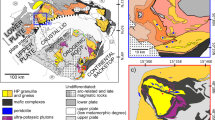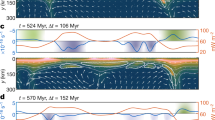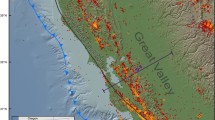Abstract
The hypothesis that much of the lithosphere of the Archaean Tanzania Craton was hydrated, by the dehydration of a buoyant subduction 2 Ga ago is presented in this study. Buoyant subduction is a potential mechanism for thermal erosion and metasomatism of extensive regions of the cold overlying continental lithosphere. This hypothesis could explain why the Tanzania Craton forms an undeformed island within the intensely deformed mobile belts. Furthermore, it would explain the formation of the eclogite and lherzolite bearing kimberlites within the Tanzania Craton far away from the trench. A buoyant, slow subduction is required because this would provide sufficient cooling from the overlying cratonic lithosphere and therefore the dipping slab could retain hydrous minerals such as antigorite in hydrated aureoles in peridotites. To test this hypothesis, the release of water during prograde metamorphism of a flat-subducting plate was modeled. It is shown that water can be transported ∼800 km laterally, inboard of the trench, which is close to the north-south extension of the Archaean Tanzania Craton.





Similar content being viewed by others
References
Baker BH, Wohlenberg J (1971) Structure and evolution of the Kenya Rift Valley. Nature 229:538–542
Brown GC, Musset AE (1993) The Inaccessible Earth, an Integrated View of Its Structure and Composition. Chapman and Hall, London
Cahen L, Snelling NJ (1994) The Geochronology and Evolution of Africa. Clarendon, Oxford
Carlson RW, Pearson DG, James DE (2005) Physical, chemical, and chronological characteristics of continental mantle. Review of Geophysics 43:RG1001
Collins AS, Reddy SM, Buchan C, Mruma A (2004) Temporal constraints on Paleaeoproterozoic eclogite formation and exhumation (Usagaran Orogen, Tanzania). Earth Planet Sci Letters 224:175–192
Connolly JAD (1990) Multivariable phase diagrams; an algorithm based on generalized thermodynamics. Am J Sci 290:666–718
Cooper CM, Lenardic A, Moresi L (2004) The thermal structure of stable continental lithosphere within a dynamic mantle. Earth Planet Sci Letters 222:807–817
Dawson JB (1992) Neogene tectonics and volcanicity in the North Tanzania sector of the Gregory Rift Valley: contrasts with the Kenya sector. Tectonophysics 204:81–92
Dixon JE, Dixon TH, Bell DR, Malservisi R (2004) Lateral variation in upper mantle viscosity: role of water. Earth Planet Sci Letters 222:451–467
Edwards CB, Howkins JB (1966) Kimberlites in Tanganyika with special reference to Mwadui occurrence.. Eco Geology 61:537–554
English JM, Johnston ST, Wang K (2003) Thermal modelling of the Laramide orogeny: testing the flat-slab subduction hypothesis. Earth Planet Sci Letters 214:619–632
Fritz H, Tenczer V, Hauzenberger CAH, Wallbrecher E, Hoinkes G, Muhongo S, Mogessie A (2005) Central Tanzanian Tectonic Map (CTTM): A step forward to decipher pre-Pan-African and Pan-African structural events in the East African Orogen. Tectonophysics 24:TC6013
Gobba JM (1996) Characteristics of diamonds in Tanzania. In: Kogbe CA (ed) Diamond Deposits in Africa. Africa Geoscience Review, Special Edition, 117–137
Hacker BR, Albers GA, Peacock SM (2003) Subduction factory—1. Theoretical mineralogy, densities, seismic wave speeds, and H2O contents. J Geophys Res—Solid Earth 108
Hirth G, Kohlstedt DL (1996) Water in the oceanic upper mantle; implications for rheology, melt extraction and the evolution of the lithosphere. Earth Planet Sci Letters 144:93–108
Ito M (1986) Kimberlites and their ultramafic xenoliths from western Kenya. TMPM Tschermaks Min Petr Mitt 35:193–216
Ito M, Suwa K, Segero AS (1983) Petrographical note on the xenoliths in YA17 kimberlite from Nyanza, western Kenya. Prelim Rep Afr Stud Nagoya Univ 8:197–204
Jagoutz E (1988) Nd and Sr systematics in an eclogite xenolithe from Tanzania—evidence for frozen mineral equilibria in the continental lithosphere 52:1285–1293
Jordan TH (1978) Composition and development of the continental tectosphere. Nature 274:544–548
Lenardic A, Moresi LN (1999) Some thoughts on the stability of cratonic lithosphere; effects of buoyancy and viscosity. J Geophys Res 104:12747–12759
Lenardic A, Moresi LN, Muhlhaus HB (2003) Longevity and stability of cratonic lithosphere: insights from numerical simulations of coupled mantle convection and continental tectonics: J Geophys Res 108: doi:10.1029/2002JB001859
McDonough WF, Sun SS (1995) The composition of the earth. Chem Geology 120:223–253
Möller A, Appel P, Mezger K, Schenk V (1995) Evidence for a 2 Ga subduction zone: eclogites in the Usagaran belt if Tanzania. Geology 23:1067–1070
Molnar P (1988) Continental tectonics in the aftermath of plate tectonics. Nature 335:131–137
Moresi L, Solomatov V (1998) Mantle convection with a brittle lithosphere: thoughts on the global tectonic styles of the Earth and Venus. Geophys J Int 133:669–682
Moresi L, Dufour F, Muhlhaus HB (2002) A Lagrangian integration point finite element method for large deformation modeling of viscoelastic geomaterials. J Comp Phys 184:476–497
Muhongo S, Kröner A, Nemchin AA (2001) Single zircon evaporation and SHRIMP ages for granulite-facies rocks in the Mozambique Belt of Tanzania. J Geology 109:171–189
O’Reilly SY, Griffin WL, Djomani YH, Morgan P (2001) Are lithospheres forever? Tracking changes in subcontinental lithospheric mantle through time. GSA Today 11:4–10
Peacock SM (1990) Fluid processes in subduction zones. Science 248:329–337
Peacock SM (1996) Thermal and petrologic structure of subduction zones. In: Bebout GE, Scholl DW, Kirby SH, Platt JP (eds) Subduction top to bottom, 96, American Geophysical Union 119–133
Pearson DG, Carlson RW, Shirey SB, Boyd FR, Nixon PH (1995) Stabilization of Archaean lithospheric mantle: a Re-Os isotope study of peridotite xenoliths from the Kaapvaal craton. Earth Planet Sci Letters 134:341–357
Ranero CR, Morgan JP, Mcintosh K (2003) Bending—related faulting and mantle serpentinitization at the Middle American trench. Nature 425:367–373
Reddy SM, Collins AS, Mruma A (2003) Complex high-strain deformation in the Usagaran Orogen, Tanzania: structural setting of Palaeoproterozoic eclogites. Tectonophysics 375:101–123
Reid AM, Brown RW, Dawson JB, Whitefield GG, Siebert JC (1976) Garnet and pyroxene compositions in some diamondiferous eclogites. Contrib Mineral Petrol 58:203–220
Rombouts L (1985) Kimberlites in western Kenya. Annales de la Société Géologique de Belgique 108:369–375
Rüpke LH, Morgan JP, Hort M, Connolly JAD (2004) Serpentine and the subduction zone water cycle. Earth Planet Sci Letters 223:17–34
Sklyarov EV, Theunissen K, Melnikov KL, Klerkx J, Gladkochub DP, Mruma A (1998) Paleoproterozoic eclogites and garnet pyroxenites of the Ubende belt (Tanzania). Schw Min Petro Mit 78:257–271
Sommer H, Kröner A, Hauzenberger C, Muhongo S (2003) Metamorphic petrology and zircon geochronology of high-grade rocks from the central Mozambique Belt of Tanzania: crustal recycling of Archean and Palaeoproterozoic material during the Pan-African orogeny. J metamorphic Geology 21:915–934
Sommer H, Kröner A, Hauzenberger C, Muhongo S (2005a) Reworking of Archaean and Palaeoproterozoic crust in the Mozambique belt of central Tanzania as documented by SHRIMP zircon geochronology. J African Earth Sci 43:447–463
Sommer H, Kröner A, Muhongo S, Hauzenberger C (2005b) SHRIMP zircon ages for post-Usagaran granitoid and rhyolitic rocks from the Palaeoproterozoic terrain of southwestern Tanzania. South African J Geology 8:247–256
Sommer H, Kröner A, Hauzenberger C, Muhongo S (2008) Isothermal decompression history in the “Western Granulite” terrain, central Tanzania: evidence from reaction textures in metapelites and trapped fluids. J African Earth Sci 51:123–144
Walker RJ, Carlson RW, Shirey SB, Boyd FR (1989) Os, Sr, Nd, and Pb isotope systematics of southern African peridotite xenoliths: implications for the chemical evolution of subcontinental mantle. Geochim Cosmochim Acta 53:1583–1595
Williams AF (1932) The genesis of the diamond. Ernest Benn Limited, London, 2 Volumes, Vol. 1, 352 + vi pp; Vol. 2., 636 + iv pp. Tanzanian Eclogite Xenoliths 1:333–336
Acknowledgements
The author thanks Christoph Hauzenberger for the fruitful and energizing discussions, and for providing Fig. 1. The author also appreciates Craig O’Neill for assistance in handling Ellipses. Two anonymous reviewers provided critical and helpful reviews, Georg Hoinkes and Rainer Abart are acknowledged for the editorial handling of the manuscript. This is a contribution to IGCP Project 557.
Author information
Authors and Affiliations
Corresponding author
Additional information
Editorial handling: G. Hoinkes
Rights and permissions
About this article
Cite this article
Sommer, H. “Wet” low angle subduction: a possible mechanism below the Tanzania craton 2 Ga ago. Miner Petrol 96, 113–120 (2009). https://doi.org/10.1007/s00710-009-0048-3
Received:
Accepted:
Published:
Issue Date:
DOI: https://doi.org/10.1007/s00710-009-0048-3




